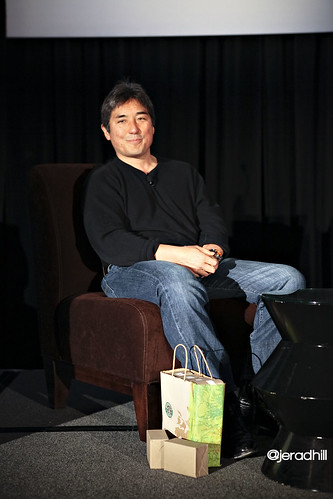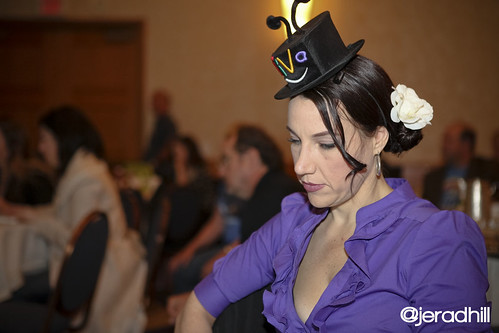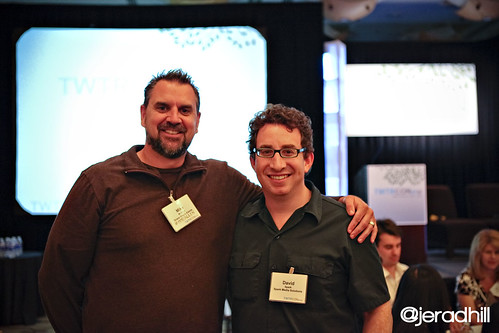I attended TWTRCON in San Francisco today. I tweeted away (@dspark) along with a packed conference that just begun its planning eight weeks ago. Just goes to show how successful you can be in the conference industry is if you ride a very successful meme or phenomenon.
Here’s a summary of the cool and not-so-cool items seen and mentioned at the conference.
NOT SO COOL (CORRECTED-It’s COOL/NOT SO COOL) – Guy Kawasaki and his “ghost twitterers” – Guy Kawasaki (@GuyKawasaki) publicly admitted once again that he has “ghost twitterers” tweeting for him. If that’s the case, then he has to stop referring to them as “ghost twitterers.” The definition of ghostwriting (or “ghost twittering” in this case) is to take credit for someone else’s work. When asked point blank about it, Kawasaki admits it, but for the people who don’t ask, he’s taking credit for other people’s work.
 To defend his actions, Kawasaki likens what he does with his Twitter account to what Oprah does with her magazine. Oprah doesn’t write all the articles in her magazine, Kawasaki said. Yes that’s true, but Oprah doesn’t try to fool the majority of her readers into believing that she wrote the entire magazine. She gives bylines to her writers. Guy doesn’t. He only admits he’s not the only writer when asked. He doesn’t volunteer that information.
To defend his actions, Kawasaki likens what he does with his Twitter account to what Oprah does with her magazine. Oprah doesn’t write all the articles in her magazine, Kawasaki said. Yes that’s true, but Oprah doesn’t try to fool the majority of her readers into believing that she wrote the entire magazine. She gives bylines to her writers. Guy doesn’t. He only admits he’s not the only writer when asked. He doesn’t volunteer that information.
Since Kawasaki wants to take advantage of his 125,000 followers, but doesn’t want to do all the twittering himself, he needs to fully disclose his behavior in the following way:
- Set up a Web page with bios of all the people who Twitter for you. Make that page easily available.
- Once a day, tweet the link to the guest twitterers’ biography page.
- Have the guest twitterers tag each @GuyKawasaki tweet with their initials so people know who did the tweeting. In fact, this is the standard for CoTweet. They tag every thing with initials (e.g. ^DS for David Spark).
- Start referring to them as “guest twitterers” and not “ghost twitterers.”
UPDATE: I have been corrected by Jesse Engle, see comment below. It turns out that Guy Kawasaki DOES give credit via initials to his guest twitterers. He just lists them by name on his Twitter page. He should go further and provide bios.
COOL – Twitter contests – I’m a big fan of using contests to grow your social network. Seth Greenberg, Director of Online Advertising and Internet Media at Intuit told a story about holding a contest on Twitter for TurboTax. Intuit asked Twitterers “If you were a rock star, what would you like to deduct with TurboTax?” The contest got 6,000 entries, but the most important metric was the number of followers (or impressions) that heard about the contest, which was a total of 1 million, said Greenberg.
 COOL – The endless Twitter clients for group management – There are a bunch of Twitter clients for (e.g. HootSuite, CoTweet, TweetFunnel, ObjectiveMarketer) managing tweets across a group. These tools allow you to manage multiple people within a group, monitor behavior, and assign tasks all within Twitter. Warning, these are power user products.
COOL – The endless Twitter clients for group management – There are a bunch of Twitter clients for (e.g. HootSuite, CoTweet, TweetFunnel, ObjectiveMarketer) managing tweets across a group. These tools allow you to manage multiple people within a group, monitor behavior, and assign tasks all within Twitter. Warning, these are power user products.
COOL/NOT-SO-COOL – Projecting all the #TWTRCON tweets next to the stage – I have a love/hate appreciation for publicly projecting the Twitter stream from the event. It’s great because it promotes the stream and provides additional content beyond what’s being said on stage. I hate it because the public presentation to the whole room and next to the presenters hinders twitterers from making critical comments.
 NOT-SO-COOL – Lack of how to’s – The meat of the programming is about brand management and delivering customer service through Twitter. I would have liked to see on stage how these companies actually listen and do brand management through the variety of tools they use (e.g. PeopleBrowser, Radian6, TweetDeck, Visible Technologies).
NOT-SO-COOL – Lack of how to’s – The meat of the programming is about brand management and delivering customer service through Twitter. I would have liked to see on stage how these companies actually listen and do brand management through the variety of tools they use (e.g. PeopleBrowser, Radian6, TweetDeck, Visible Technologies).
COOL – Arguing – There was tons of arguing from the audience and the panelists. People attacked how people tweeted. Others defended how they tweeted (e.g. Guy Kawasaki). Rafe Needleman (@rafe) demanded to know where these big companies such as Boingo and Comcast were justifying budgets to hire staffs to get people to Twitter. Not surprisingly, they just dodged the question. Rafe and the rest of us really wanted to know.
 COOL – You CAN manage the release of announcements through Twitter – One person asked a question about getting ignored on Twitter. He said he would ask a question of a celebrity or a big corporation and he got ignored. It made him feel a little down (there was a communal “Awwwww” from the audience).
COOL – You CAN manage the release of announcements through Twitter – One person asked a question about getting ignored on Twitter. He said he would ask a question of a celebrity or a big corporation and he got ignored. It made him feel a little down (there was a communal “Awwwww” from the audience).
MC Hammer said he unfortunately has to ignore people’s requests all the time, because they ask questions for things he’s not ready to talk about, like the TV show he was about to do. Later, when he was ready to talk about the TV show, he talked about it. MC Hammer reiterated that you can control the release of your announcements through Twitter.
COOL – Business often starts from innocuous conversations – Shel Israel, author of the upcoming book, Twitterville, pointed out that we rarely begin business with business conversations. But rather we begin business with a casual non-business-oriented conversation (e.g. sports, fashion, entertainment). One shouldn’t knock the “I just had a cheese sandwich” Tweet because it could lead to greater business opportunities.
NOT-SO-COOL – Preaching to the choir – Way too much of the dialogue on stage was speaking to the choir of the value of Twitter. Unfortunately, I would say this was the theme of the entire event.
My advice for the next TWTRCON – Less talking heads. More demos of experiences
You’ve got the visuals, you’ve got the talking heads. Synchronize them. Force the talking heads to actually show demos of what they’ve done to manage customer service using Twitter. Have them explain mistakes they’ve made, what they’ve done to streamline processes, and let them show how they’ve managed the entire process flow of conversation through the Twittersphere and all other social media tools.
A final thanks to Jerad Hill Photography for all the great photos used in this post. And that photo above is of me and my friend Mike McAllen of Grass Shack Events and Media.





